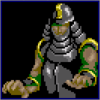I’ve started to feel dirty clicking on icons like some sort of peasant.
But it’s actually better!
I know it’s easy to think that it’s about showing off, but honestly, the Linux graphical tools are much worse than the command line most of the time.
Installing software is much faster and more reliable using the command line than any graphical tool I’ve used.
What gives me real power is sudo.
As an experiment, I set up a laptop with what I call Linu (Linux without X).
Just wanted to see how much functionality I could get on a CLI/framebuffer-only system.
I was pretty surprised. It could browse the web (with graphics), manage e-mail, view pdf files, read e-books, listen to music, torrent and watch movies, play some games, multitask…It wasn’t practical at all, but definitely turned my netbook into a fun toy.
You know what, i just drop my personal list of noteworthy shell-tools here (note directfb2 and twin). And edir, clipboard, pass and portal/croc for the win.
alternatives
GUI alternatives
- draw: mouse drawing on the shell!
- imgfb: Draws a farbfeld or jpeg image to the Linux framebuffer
- baca: TUI e-book reader
- Terminal Image Viewer (tiv): what it says
- FIM: framebuffer image viewer -;derasterize: cli pixel to ANSI converter cli video playing: mpv --gpu-context=drm
- ts-polkitagent: Polkit Agent for the Shell (old)
- fbterm: framebuffer terminal
- twin: Textmode WINdow environment
- directfb2: framebuffer desktop
- csv to ascii art table via python pandas
Task Management:
- dun: note-taking & task manager
- cubby: encrypted note taking to cloud, with markdown
- girok: TUI calendar
Services:
File Manager:
- clifm: nice shell file manager with tagging
- nnn: cli fm with split-view file preview
- TUIFI Manager: cli fm with rendered images in 2D layout
- xplr: hackable, minimal, TUI fm
Login Manager:
Others:
ease of use
- edir: rename with text file
- clipboard: shell clipboard manager & more
- portal: cli file transfer agent between computers
- croc: simple file transfer tool via local server, Android Appp too
- transfer.sh: cli file sharing via cloud
- detox: file name cleanup
- ouch: simple de/compressor
- mnamer: intelligent video renamer
- gum: bells and whistles for shell scripters
- pytermgui: bells and whistles for python scripters
If someone has more/better tools, please shout.
A dirty linux admin here. Imagine you get ssh’d in nginx log folder and all you want to know are all the ips that have been beating againts certain URL in around last let’s say last seven days and getting
429most frequent first. In kittie script its likefind -mtime -7 -name "*access*" -exec zgrep $some_damed_url {} \; | grep 429 | awk '{print $3}' | sort | uniq -c | sort -r | lessdepends on how y’r logs look (and I assume you’ve been managing them - that’s where thezgrepcomes from) should be run intmuxand could (should?) be written better 'n all - but my point is - do that for me in gui(I’m waiting ⏲)
As a general rule, I will have most of my app and system logs sent to a central log aggregation server. Splunk, log entries, even cloudwatch can do this now.
But you are right, if there is an archaic server that you need to analyse logs from, nothing beats a find/grep/sed
The nicest aspect, for me, is that I rarely need to do something just once. So while I sometimes prefer a GUI workflow for a simple one-off, if it’s something I may end up repeating, then I’d rather have a command-line approach which can be chucked in a shell script, run by cron, or easily invoked over ssh on my phone.
But for highly interactive things (e.g., reading email), I’ll stick to GUI solutions like a pleb.
I know it’s faster and even easier for many things, but it’s with great shame that I would rather mess with network interfaces via GUI than on command line.
nmtuiis a poor substitute.I wish I was better at using the terminal. I’m running EndeavourOS as my daily driver, so I use it a lot but I wish I was even more comfortable with it. Are there any good crash courses available for noobs?
Linuxcommand.org is a great start. Writing shell scripts and using cli programs for things you actually need and will use will greatly accelerate learning. I stopped using a file manager entirely to force myself to learn how to get around, then switched to neovim from vscodium, taskwarrior instead of Obsidian Tasks, termdown for timers, etc. A tiling wm makes the transition easier imo because you can have many terminals open for visual multitasking. Like with anything, you’ll get better faster if you just do it a bunch and don’t be afraid to mess up and get your hands dirty.



